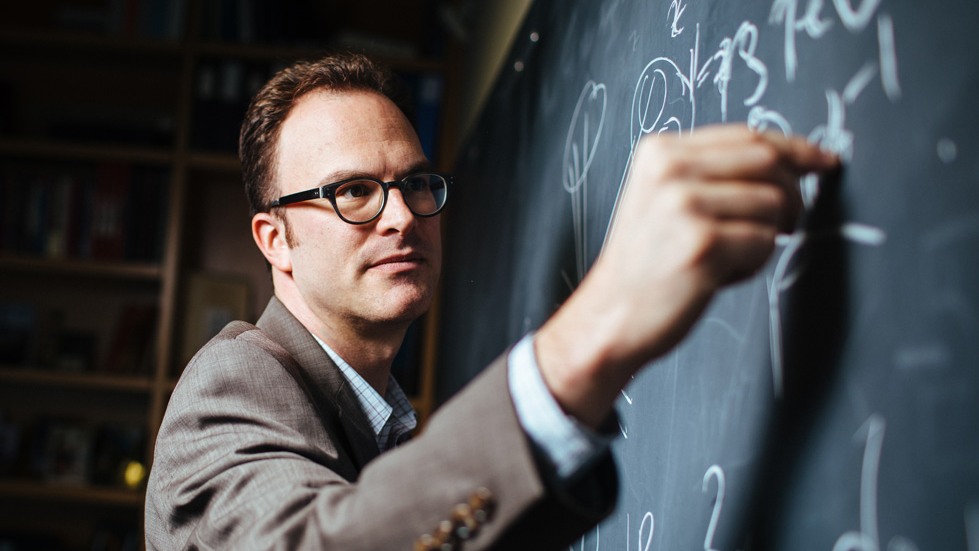Jesse Diaz Thaler ’02 is a professor of physics at MIT and Director of the NSF Institute for Artificial Intelligence and Fundamental Interactions (IAIFI). He is affiliated with the MIT Center for Theoretical Physics, MIT Laboratory for Nuclear Science, MIT Statistics and Data Science Center, and the MIT Institute for Data, Systems, and Society. He talked with us about his formative experiences at Brown Physics, chief among which was his access to the physics faculty.
Professor Thaler was the featured speaker at the Maurice & Yetta Glicksman Forum sponsored by the Division of Research on Saturday, May 24th, as part of Brown's Commencement Weekend activities. His talk was titled "Deep Learning + Deep Thinking = Deeper Understanding."
1. What advice do you have for our undergraduate concentrators?
I have three pieces of advice that I give to anyone who will listen. The first is to “find mentors.” Even now, as a faculty member at MIT, I have around five senior colleagues I regularly turn to for advice. As a younger scientist, having someone (preferably multiple people) looking out for your best interests and giving honest feedback is even more critical.
The second is to “be visible.” Somehow, society’s image of a physicist is that of a lone genius toiling away in a closed office. The reality is that physics (especially theoretical physics) is a social enterprise, with many research ideas arising at blackboards and around coffee machines.
The third is to “tell a story.” Science is a process of discovering the ultimate truths of nature, and while those truths are independent of the research process, the research process is shaped by the personalities involved. To ensure that other scientists (and the public) understand and appreciate your work, you need to make an effort to explain not just the results of your work but also why it is important and how it fits into the narrative arc of the field.
2. What about being at Brown contributed to your success?
I came to Brown because I wanted a full liberal arts experience. So even as I took many math and physics classes, I also enrolled in as many upper-level humanities courses as possible. These humanities classes taught me how to think clearly and write persuasively, but more importantly, they taught me the value of confronting ambiguity. We don’t usually think of physics as ambiguous (at least not the version taught in classrooms), but physics research often involves weighing competing effects.
What I didn’t know was how welcoming the Physics Department would be, especially regarding access to professors and opportunities for research. If only I could spend as much time with my current students at MIT as my Brown professors did with me!
3. What is your fondest memory of your time at Brown?
It’s helpful to distinguish between Type I fun and Type II fun. Type I fun is enjoyable in the moment, and certainly the debaucherous celebration after taking the Physics GRE counts in that category. Type II fun is enjoyable only in retrospect. I was a jazz DJ on 95.5 WBRU, spinning vinyl records from 2:00 to 5:30...in the morning. After my shift, I’d grab a breakfast sandwich from Loui’s, try to sleep for a few hours, then head bleary-eyed to my 9:00 a.m. Quantum Mechanics class. Jazz and physics (and insomnia) are my favorite things!
4. Who at Brown contributed the most to your academic journey, and who would you like to thank?
It’s wonderful that some of my Brown peers and professors are now my physics colleagues! The aforementioned debauchery was with my classmate, Jahred Adelman ’02, who is also a professor working in particle physics. I took a course on “Experiments in Modern Physics” from Prof. Greg Landsberg; I regularly see Greg at particle physics conferences, and based on my course performance, I assume he approves of my choice to pursue theoretical research.
There are many other names I could drop, but the two physics professors who influenced me most were Prof. Bob Pelcovits and Prof. Antal Jevicki; they were essential mentors to me along my physics journey. Bob was a spectacular teacher and conscientious advisor who encouraged me to aim high. Antal was also a great teacher, but more importantly, he was an inspiring research mentor who showed me that you didn’t need to know everything to discover something new.
So, while the cinderblock walls of Barus and Holley weren’t particularly welcoming, I am grateful to the people inside those walls who made Brown Physics my home. I am looking forward to returning to campus!
